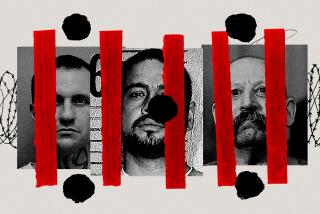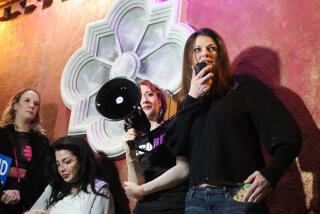Chippendale’s Owner Held in Murder Plot : Crime: Somen Banerjee is charged with conspiracy in alleged scheme to kill three former associates.
The owner of Chippendale’s, the Mid-Wilshire male stripper club, was arrested Thursday and charged with conspiring to kill three of his former business associates.
Somen (Steve) Banerjee, 46, of Playa del Rey, was charged with conspiracy to violate the federal “murder for hire” statute and with five counts that involve sending individuals and money abroad in furtherance of the murder scheme, according to an indictment unsealed Thursday.
The charges involve an alleged plot in 1990 and 1991 to kill Mike Fullington, Read Scot and Steve White, Banerjee’s former associates who at the time were affiliated with what was described as a rival dance group called Adonis. Scot had once served as the emcee for shows at Chippendale’s.
If convicted on all counts, Banerjee faces a prison term of up to 55 years and a fine of up to $1.5 million, U.S. Atty. Terree A. Bowers said.
Charlie Parsons, the special agent in charge of the FBI’s Los Angeles office, said the bureau’s organized crime unit had investigated the alleged plot for two years.
Banerjee appeared calm Thursday as he was ordered held without bail by U.S. Magistrate Judge Venetta S. Tasopulos. Arraignment was scheduled for Tuesday.
In arguing that Banerjee should be detained, Assistant U.S. Atty. Sally Meloch said that last February Banerjee told an informant in Zurich that he had “plans to leave the country or kill himself” if apprehended. He also told the informant that he would return to his native India and “would get a new wife and new kids,” Meloch said.
The prosecutor also said Banerjee told the informant that he did not need a passport because he could pay a pilot $25,000 to fly him out of the country. Tasopulos said Banerjee had the ability to flee the country “because of his tremendous assets.”
Banerjee’s attorney, Robert Isenberg of Malibu, said his client is not guilty. He called the charges “preposterous and unfounded.”
According to the indictment prepared by Meloch and Assistant U.S. Atty. David Scheper, the plot was hatched in 1990 and neared consummation in August, 1991. But the indictment does not offer a motive.
Also described is an elaborate plot to kill the three, including a series of meetings, trips and phone calls during the first eight months of 1991. The allegations include:
* Hiring of Ralph Angel Colon, an alleged co-conspirator who has not been indicted, to arrange for the murder of Fullington, Scot and White, and providing Colon with $7,000 to $8,000 as a down payment to arrange the killings.
* Promising Colon he would pay $25,000 to the person Colon hired to murder White and $25,000 to the individual Colon hired to murder Scot.
* Hiring by Colon of an unnamed individual to travel to England in June, 1991, to murder Scot and White while the dance troupe was performing there.
* Preparing “a cyanide mixture to be used in the murders” of Scot and White.
* Sending the hired killer to London with $1,200, a map, directions, lodging information and the Adonis itinerary.
The story ends there in the indictment. It does not disclose how the alleged plot was foiled. A source close to the case said federal agents became aware of the scheme by gaining the cooperation of the individuals involved.
Tasopulos asked Meloch why the arrest came two years after the plot allegedly ended. The prosecutor responded only that it was a long-term, ongoing FBI investigation.
A native of Bombay, Banerjee bought a down-and-out West Los Angeles disco called Destiny II in 1975 and renamed it Chippendale’s. Four years later, he launched the club’s “Male Exotic Dance Night for Ladies Only” and soon was drawing overflow crowds.
Shows at Chippendale’s explored sexual fantasies, interspersed with dance routines. For a $20 admission, women could ogle and kiss sweaty, tanned, well-muscled young men in G-strings.
At the height of his success, Banerjee had clubs in Dallas, Denver and New York that spawned a bevy of imitators.
But he also has had a series of run-ins with government agencies and business associates that caused him to file for reorganization under federal bankruptcy laws in 1987 and to move the club to the Mid-Wilshire area in 1988 after violating city ordinances on overcrowding.
One Fire Department official said that Chippendale’s was the “worst violator” he had encountered in 10 years and endangered the safety of its patrons with overcrowding and by blocking exits.
The club was permitted to have 299 patrons and fire officials said they counted 435 one evening.
In the summer of 1988, the state Department of Alcoholic Beverage Control revoked Chippendale’s liquor license after its appeals board upheld charges that the club refused to admit males in violation of a state law barring sexual discrimination.
More to Read
Sign up for Essential California
The most important California stories and recommendations in your inbox every morning.
You may occasionally receive promotional content from the Los Angeles Times.










